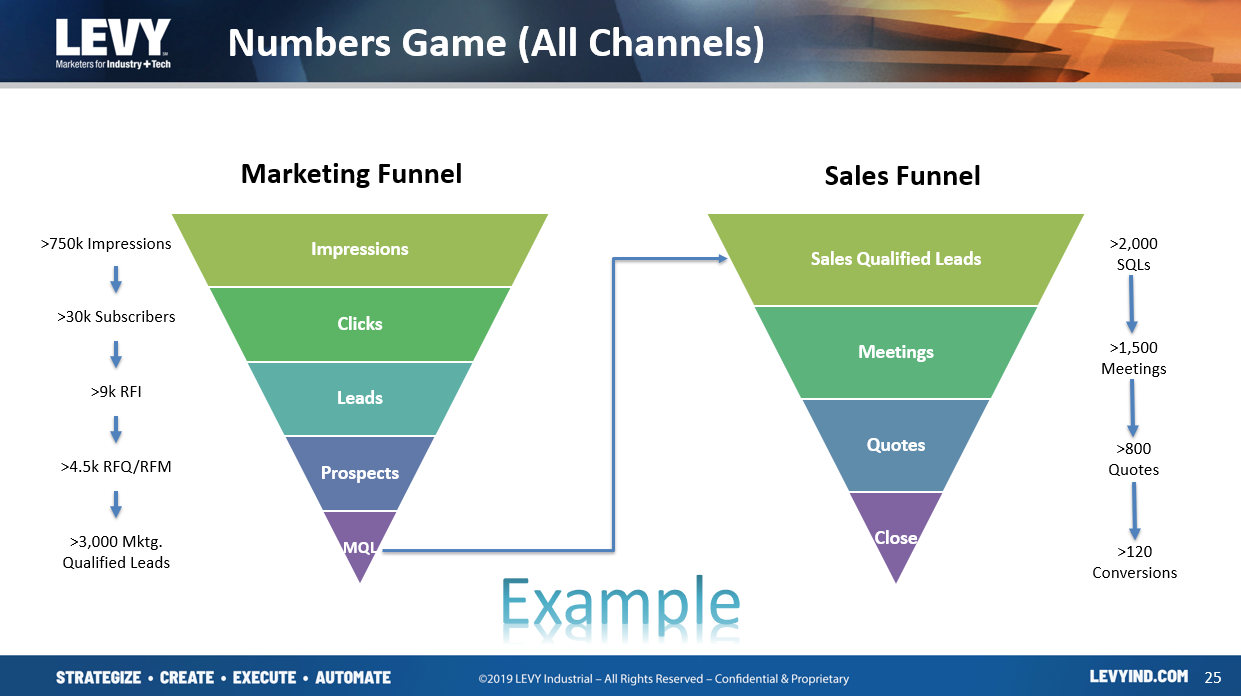Last week, in my previous blog, I talked about the WHY of Making Your Marketing Count. This week, we’ll dive into the WHAT, and next week we'll look at the HOW.
In my career, I learned a few lessons the hard way:
- Understanding the magnitude of the growth challenge
- Focusing quickly on what I could influence, and
- Developing and executing on SMART objectives.
Below, we'll take an in-depth look at each of those factors.
 Tip 1: Understanding the magnitude of the growth challenge as it relates to marketing led initiatives.
Tip 1: Understanding the magnitude of the growth challenge as it relates to marketing led initiatives.
The journey started a few years ago when I arrived at a mid-cap company in Pennsylvania. It was a new challenge for me to shift from product-centric to market-centric positioning. I was leading the Aerospace Market. Gladly, management gave me essentially carte blanche to create a play. I started the traditional route of visiting clients, going to shows, listening to product pitches, and more.
I quickly began to formulate a strategy to reach fewer than 2,200 clients globally with a focus on a niche sub-market (material and application). Think of Account-Based Marketing (ABM). We divided the world, added regional leaders, created a play, and off we went. Result: 4x growth in 5 years.
Let’s step back: “Created a Play” was inspired largely by the work we did at my previous employer using a process called “Green Belt for Growth.” The idea is to take a structured approach to growth plans using Six Sigma tools. Fast forward to what matters in this discussion, we had a goal ($M’s), we knew how much a “deal” or a “project” was worth on average, we knew how many proposals it took to get an order, and we knew how many conversations we needed to get proposal requests. In short, we knew how many leads we needed to meet the objectives.
Since I was accountable for both marketing (directly) and sales (indirectly) at that time, I could easily connect the dots and work on the marketing plan with my team. Since this was ABM, the play was less about “clicks” and “send an RFQ” buttons on web pages or ads. It was more about inbound and select outbound events. We created an aura around being the “experts” in “material x” and invited select influencers to exclusive branded industry events on all continents. The objective was to reach 1,000 leaders in less than nine months. We did it in less than a year.
So, let’s dissect this idea into practical tips for as many of you as I can in this forum: Here’s an example of the model we always use with our clients at Levy. This approach results from all those years of being in the field, and leading sales & marketing teams globally:

On the right, we look at what’s termed the Sales Funnel. We want to walk up from the bottom, the goal, and climb up to how many leads we need from Marketing. On the left, we look at the aptly named Marketing Funnel and climb up a similar ladder to determine how many impressions are needed to generate leads. Note: This is a simplified view of the real world that may have multiple channels, media, products, brands, geographies, and other factors to consider.
You can make it as complicated as needed, as we did. The good news: Using the same logic for all unique instances, you can aggregate them at the top of the funnel and paint a clear picture that everyone on the team can understand. The idea is to have a single set of metrics and to know where you are at any given time.
In fact, I asked my team to build a quick calculator so you can understand the magnitude of your challenge. Once again, highly simplified, but directionally correct. Answer 6 or 7 questions, and you’ll get an idea. We also placed industry averages for reference, in case you'd like to benchmark yours.


 Tip 2: Focus Quickly on what YOU can Influence (and What Matters)
Tip 2: Focus Quickly on what YOU can Influence (and What Matters)
How did we decide, in the last example, that ABM, Inbound, and Invitationals were the answer? Well, this is where you need to build for your business a customized funnel model like the one above. That's because not every sales or marketing activity or tactic works the same for every business.
In our last example, we had a narrow market with perhaps 6,000 people to reach. MBA 101: Do we spend $10k on ads that will reach hundreds of thousands of people with a return of <0.0001% on our demographic pool, or do we spend $10k to invite 100 influencers to an exclusive event? In that particular case, the answer was really clear.
To get the answer, you need to look at all the options in front of you: Every marketing and sales tool and tactic available. Once you have the list and effectiveness of each part in relation to effort/budget, start climbing up both funnels from goal to impressions.
Now that you know the challenge, let's figure out the most effective way to meet your goals: There are only two ways of getting to the number of leads you need: Publish a lot more to a lot more people or focus on the efficacy of your delivery methods. The right answer is that you need to do both.
Let’s look at a different example: At my company, Levy, we need $X in growth this year, and we know what our LTV is (Long Term Value of a customer). Working with our Vice President of New Business Development over the past 6 months, we have a pretty good idea about the sales funnel steps and what is necessary to be effective at each step. That exercise gave us the number of leads (NNN) we need this year to meet our goals.
We invited our Marketing Director to participate in the process and, working with her team, we looked at the many options we have within our budget: Social, Web, Blogs, eNews, Videos, Ads, SEO, etc. For each tool, we researched our experience and calculated an alphabet soup of ratios CPC, CPR, CPL… and put all this is in a proprietary model we use to make decisions.
The model we created informs us of the impact of tuning discrete activities up and down. By doing so, we can see the impact on the lead count and the budget drainage. We call that "dialing in" the plan using all the “knobs we can turn” to influence our results.
Interestingly, many of our customers have asked us to work on their models with them. With some clients, we’re now using the model during our monthly reviews. It truly changes the dynamic. “Make your Marketing Count” is becoming real.
The secret is to understand YOUR data and work on the things YOU can influence.
 Tip 3: Develop and Execute SMART Objectives
Tip 3: Develop and Execute SMART Objectives
The concept is not new. SMART objectives have been around for a long time. However, it is worth spending a few moments on how to use it. The theory is that objectives must be Specific, Measurable, Actionable, Realistic, and Timely for the process to work.
Lets piggyback on the Levy example we just looked at: At Levy, Marketing and Sales now have a solid basis for what the goal, budget, and activities are for 2020. We also went one level deeper: Assigning SMART objectives to every activity for the next 90 days.
Things move so fast in digital marketing that projecting farther than 90 days ahead is wasting your time. Every month, we review the objectives and results of our activities for the past 30 days. We adjust as needed by determining activities for the next 90 days and their associated SMART objectives. The activities or options we have (think of knobs you dial to get the sound up or down on your music system) rarely change, but what changes are the priority and intensity assigned to them, For example, in the current pandemic environment and, for good reasons, the limitations that it imposes on traditional activities such as trade shows, we may decide to shift budgets from participating in events to trying to engage with people remotely with virtual experiences.
A SMART Objective could look something like this:
In the next 30 days, campaign “XXX” will use funds from event "YYY" that was cancelled to generate N qualified leads within 150 miles of "HQ" by reaching NNN decision-makers working in "SPECIFIC MARKETS, FUNCTIONs..." using "TACTIC A, MEDIA B, ..."
This is obviously timely and hits all the SMART buttons. So, there you have it: Executing with short-term SMART objectives in-mind is the secret. In my Aerospace example, we met weekly with my core team. We had a simple Excel spreadsheet we called RAIL (Rolling Action Item List) that we maintained on a shared drive and made decisions weekly as to which activity had to be pushed or slowed. Hard work, but essential.
In closing, I’d like to summarize WHAT it takes to “Make your Marketing Count”: 1) Know the challenge at stake; 2) Focus on the knobs and levers that matter; and 3) Execute flawlessly.
Look for blog #3 in the series: HOW to “Make your Marketing Count.”
As always, I welcome your feedback.
Thank you!
read more...